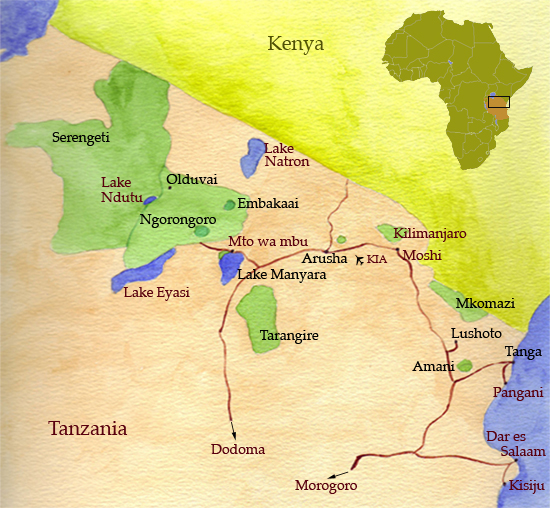|
The Serengeti National Park is quite probably the best known game park on the planet, and one of its largest: 14,763 km2. While the vast grassland plains are home to millions of herbivores such as antelopes, gazelles, zebras and wildebeests, granite outcrops called "kopjes" also provide ideal lookout points for the predators. The Serengeti, parts of the Maasai Mara in Kenya and the Ngorongoro Conservation Area (about 25,000km2) share the same ecosystem and witness every year the largest migration of mammals on earth. The Serengeti became a national park in 1951 and today is a UNESCO World Heritage Site. Its name comes from the Maasai word "siringet" which means endless plains.
|
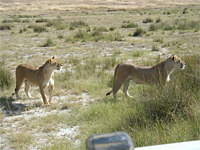 |
|
The Ngorongoro Conservation Area has an area of 8,300 km2, but its main attraction, the Ngorongoro Crater covers only 3% of that. It has been a UNESCO World Heritage Site since 1979 and is often referred to as the "eighth wonder of the world". At 600 m deep and 18 km wide, it is probably the biggest natural amphitheatre on earth. You will first be struck by its vastness, and then by the diversity of its habitats, open grassland, lakes, swamps, and forested areas. Grass, water and shade, provide the ideal living conditions for a large number of large mammals (about 25,000 animals). This is one of the rarest place in Africa where you might see the famous "Big Five": buffalo, elephant, leopard, lion and rhino. Unlike the national parks, the Maasai, who have been living there for centuries, are allowed to live in the Ngorongoro Conservation Area.
| 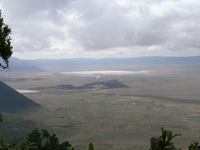 |
|
Within the Ngorongoro Conservation Area, south-east of the Serengeti, lies Olduvai, an arid and uninhabited gorge 90m deep. In 1911 a German butterfly hunter accidentally discovered fossils there. Then in 1931, Louis Leakey led an archeological expedition and began excavating the Olduvai Gorge. With his wife Mary, he spent a lifetime searching, and in 1959, the search paid off with the discovery of fragments of the 1.75 millon year-old skull of the Australopithecus boisei. Later in 1978, a trail of 3.6 million year-old footprints were discovered in Laetoli. These discoveries would for ever change the theories on the origins of humankind. A small on-site museum retraces the history of those discoveries.
| 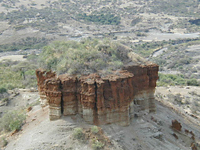 |
|
For those who enjoy walking we recommend the Olmoti and Embakaai craters in the north-eastern part of the Ngorongoro Conservation Area. The Olmoti crater rim is 3,700m high and the crater is shallow and grassy. Embakaai crater is partly filled by a deep soda lake, which many aquatic birds call home. It is possible to walk the 32 km long crater rim and to camp along the way.
|  |
|
Manyara is a small park (330 km2) located between the Rift Valley escarpment and the lake on the way to the Ngorongoro Conservation Area. From the entrance gate visitors will meet the baboons in the midst of a green and lush groundwater forest, dominated by large ficus trees and the surprising sausage trees. Beyond the forest live elephants, antelopes, buffaloes, giraffes, and wildebeests and zebras roam the floodplains. Near the lake hippos take shelter from the sun. The alkaline lake is shallow and attracts many birds including flamingos, pelicans and herons. The name "Manyara" comes from the Maasai word "emanyara", which is a euphorbia species of plant that is grown into a hedge around a family homestead.
| 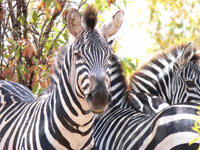 |
|
Tarangire National Park is located about 120 km west of Arusha at an altitude of 1100 m. The Tarangire River flows through the park and attracts great numbers of zebras, antelopes, giraffes and elephants. The park also boasts rarer species including the eland, oryx and gerenuk, also known as the "giraffe-gazelle". Tarangire is made of low hills, covered with acacia trees and dotted by the gigantic, mythic and most impressive baobab tree. Baobabs are grey in color and seem to glitter in the sunset, and are mostly all trunk and branches with very little leaves. Often hollow, the trees have given rise to many legends. Herds of elephants roaming among the baobab trees at sunset is an image that will remain ingrained in your mind for ever.
| 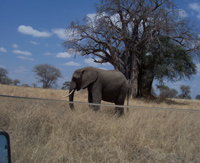 |
|
This small park of 137 km2, located 25 km north-east of Arusha, is better known for its scenery than its animal life. In addition to the Maasai who live there, the park is mostly populated by giraffes, zebras and buffaloes. You will discover Mount Meru, Ngurdoto Crater, Momella hills and its hidden alkaline lakes which are home to a great variety of birds and large flocks of flamingos. Your driver and guide will take you to the forest in search of the black and white Colobus monkey and its bushy tail. You may also go on a walking safari accompanied by a ranger. Don't forget your binoculars!
| 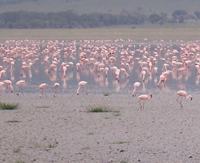 |
|
Mkomazi Game Reserve (3,700 km2) is located between the Pare Mountains and the Kenyan border. The reserve boasts some 400 different birds species, a paradise for birdwatchers. Mkomazi is not a national park, therefore walking around is permitted. In 1997, black rhinos were re-introduced in Mkomazi (they had been hunted to extinction for their horns). The new South African herd lives within an area of 46 km2 bordered by an electrified fence. Unfortunately, the herd continues to have problems reproducing is this semi-captivity.
| 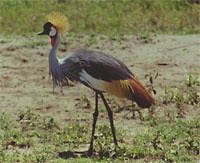 |
|
Lushoto is the main town of the Usumbara Mountains and lies 37 km from the Moshi-Dar es Salaam road. The Usambara Mountains form a superb walking country with green hills, red earth, steep-sided valleys and terrace cultivation by the Shambaa peasants. There are still some orchards, remnants of the colonial era, which produce apples, pears and plums mostly taken to market in Dar es Salaam and Arusha. There are some magnificent viewpoints at the edge of the Usambara escarpment down to the plains below.
| 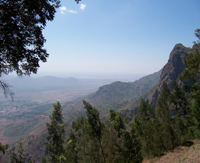 |
|
At the heart of the Eastern Usambara is the Amani Nature Reserve. Regarded as the second largest botanical garden in the world, it was first settled by Germans in 1902. The Eastern Usambara is one of the smallest of the Eastern Arc ranges ans its primeval rainforests are among the 120 most precious biodiversity areas on the planet, and the oldest in Africa: 30 million year-old! 340 different birds have been recorded including some rare, endemic or endangered species, and more than 1,000 different plants. It is a walking paradise suitable for anyone. There are also tea plantations in the region.
| 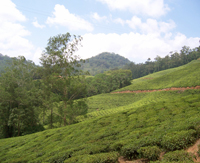 |
|
For those interested in finishing their safari on the shore of the Indian Ocean, we recommend either Peponi Resort, a small complex of bungalows 30 km south of Tanga, or the Tydes beach cottages in Pangani, across the estuary. Both places offer you a chance to relax but for the more adventurous there are also fishing trips, snorkelling and diving excursions. It is possible to fly from Tanga back to Dar es Salaam.
| 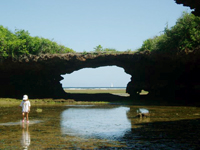 |


